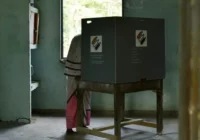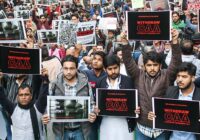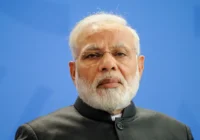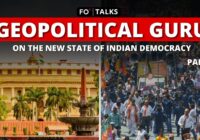In 1984, Stuart Auerbach of The Washington Post described Indira Gandhi as “Mother India” or “the Empress of India” for her supporters. One rather sycophantic one who was president of her party declared, “Indira is India and India is Indira.” Auerbach referred to Indira’s reign as “a kind of personal rule rarely found among large, modern nations.”
Indira was the daughter of Jawaharlal Nehru, India’s first prime minister from 1966. Note, she was not related to Mahatma Gandhi, the father of the Indian nation. Conveniently, many of the hundreds of millions of illiterate Indian voters and ignorant foreigners never realized that fact. Indira destroyed internal democracy within the Congress Party, centralized all power in her hands and designated her sons as her anointed successors.
Infamously, Indira ruled India as a de facto dictator for 21 months from June 25, 1975. During this period, she locked up journalists, political opponents and even eminent Gandhians (the Mahatma’s followers) who had participated in India’s freedom struggle. Indira did not even spare the elderly Jayaprakash Narayan, the most eminent living Gandhian in the 1970s, packing him off to prison just like the British once did. Her son Sanjay forced millions of men to go through sterilization, anticipating the fixation of the Chinese Communist Party (CCP) with population control.
In 1977, Indira called for elections, which she thought would result in a massive victory. Instead, voters booted her out and opted for a ramshackle opposition coalition. This was the first time the grand old Congress Party lost power in New Delhi. Since then, India avoided another brush with Indira-style authoritarianism for decades.
Sadly, Prime Minister Narendra Modi of the Bharatiya Janata Party (BJP) has changed that since he was voted into power in 2014. He has been particularly overbearing since winning a second term in 2019. Millions in India now argue that we are living through a second emergency and for good reason.
Modi’s measures have made him an Indira-like figure
Modi has engaged in a power grab of historic proportions. It is an open secret in Delhi that the Prime Minister’s Office (PMO) rules the country with an iron hand. Even ministers in Modi’s cabinet have no real power. Favored Indian Administrative Service (IAS) officers, largely from Gujarat (Modi’s home state), are the new barons and dukes who rule in the name of the prime minister.
Just as Indira weakened the Congress Party, Modi has undermined the BJP. Home Minister Amit Shah is the only one with any real power. Members of the BJP and its parent organization, the Rashtriya Swayamsevak Sangh (RSS) refer to Modi and Shah as “Ranga and Billa,” two ill-famed criminals who kidnapped and killed two siblings in 1978. Their argument is that Modi and Shah have kidnapped the BJP and the RSS, and their absolutism might kill both these organizations, which have historically been grassroots-driven organizations.
Just as Modi has sidelined the BJP and the RSS, so too has he undermined the institutions of the Indian state. Democratic principles of decentralization, accountability and separation of powers no longer matter in Modi’s India. Everyone in the government has to dance to his master’s voice.
Modi has used the Enforcement Directorate (ED) and the Central Bureau of Investigation (CBI) to persecute anyone who does not toe his line. The Modi government has used the Unlawful Activities (Prevention) Act (UAPA) and the Prevention of Money Laundering Act (PMLA) to hound business leaders, journalists and political opponents. Before the Supreme Court of India intervened on March 21, 2024, those accused under the PMLA did not even have the right to get bail. Selective use of UAPA, PMLA and other legislation has created a culture where rule by law, not rule of law, dominates. Simply put, the government uses the law to lock up or harass individuals it does not like.
Institutions are now Modi’s instruments to target his opponents. In March, the government froze the bank accounts of the Congress Party for failure to pay outstanding taxes. Authorities also arrested Delhi Chief Minister Arvind Kejriwal, who is the leader of the Aam Aadmi Party (AAP), on corruption and money laundering charges. Even many BJP/RSS leaders admit that the ED and CBI are now hounds who hunt hares for Modi and Shah. After Indira, India is once again in the grip of a climate of fear.
Freedom of the press has cratered. Modi has not given a single press conference since becoming prime minister. The Adani Group, his financial backers, has bought New Delhi Television (NDTV), the anglicized television channel that opposed Modi most. Former NDTV stars now ply their trade on YouTube or on Al Jazeera. No local television station is hiring them.
Print media is completely under the thumb of the Modi government, and social media bends to its will. After all, Twitter and Facebook make big money in India and are loath to antagonize the Modi government, which could and would hurt their bottom line. Furthermore, the Modi government has a sophisticated social media operation that disseminates propaganda, misinformation and even fake news.
Modi’s dangerous lies and anti-Muslim propaganda campaign
Modi’s social media team has bombarded WhatsApp with stories that Nehru’s grandfather was a Muslim. According to these stories, this grandfather was born in a red-light district — that part of an Indian town where prostitutes live — and the family remains closet Muslims to this day. The campaign paints Nehru to be a lover of beef, alcohol and nubile young women. As per this narrative, Nehru was a man of moral turpitude unfit to lead pious Hindus.
Numerous analysts have pointed out how the Modi-led BJP has imposed Hindu fascism in India. Note that Modi has never once expressed regret, leave aside apologized, for the 2002 Gujarat riots. These happened under his watch when he was chief minister and the US State Department barred Modi from entering the US for his suspected involvement in these brutal riots.
This year, Modi has inaugurated a temple to the Hindu god Ram on the site of a medieval mosque, which was allegedly built on a previous Hindu religious site. Modi participated in an elaborate religious ceremony personally in a blatant religious appeal for votes.
The Modi government plans to implement the Citizen Amendment Act (CAA) offering Indian citizenship to non-Muslim refugees from India’s neighboring countries. Opponents question why Parsis or Muslim sects such as Ahmadis are not included in the CAA. The answer is simple: Modi is mobilizing Hindu votes and weakening the secular fabric of the Indian republic.
For good reason, the BBC has just published a story of India’s 200 million Muslims becoming invisible in their own country. Hindu vigilantes have lynched Muslims suspected of consuming beef. Mosques are increasingly under threat. Talk of “love jihad” — Muslim men marrying Hindu women and converting them to Islam — is rife. Anti-Muslim hate speech has skyrocketed, especially in states ruled by the BJP.
This victimization of minorities makes India more like Pakistan. India’s secular democracy has been a beacon of hope to countries around the world as a shining example of how different religions and diverse communities can coexist. The Modi-led BJP government and the RSS have been slow dripping poison into the veins of Indian society. If this continues, India would make Yugoslavia look like a firecracker. By deepening and widening the Hindu–Muslim divide, Modi threatens the very idea of India.
The views expressed in this article are the author’s own and do not necessarily reflect Fair Observer’s editorial policy.
Support Fair Observer
We rely on your support for our independence, diversity and quality.
For more than 10 years, Fair Observer has been free, fair and independent. No billionaire owns us, no advertisers control us. We are a reader-supported nonprofit. Unlike many other publications, we keep our content free for readers regardless of where they live or whether they can afford to pay. We have no paywalls and no ads.
In the post-truth era of fake news, echo chambers and filter bubbles, we publish a plurality of perspectives from around the world. Anyone can publish with us, but everyone goes through a rigorous editorial process. So, you get fact-checked, well-reasoned content instead of noise.
We publish 2,500+ voices from 90+ countries. We also conduct education and training programs
on subjects ranging from digital media and journalism to writing and critical thinking. This
doesn’t come cheap. Servers, editors, trainers and web developers cost
money.
Please consider supporting us on a regular basis as a recurring donor or a
sustaining member.
Will you support FO’s journalism?
We rely on your support for our independence, diversity and quality.










Comment